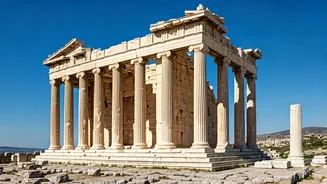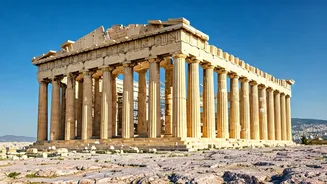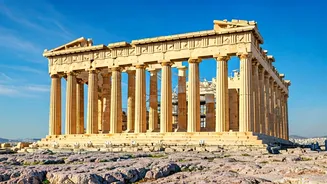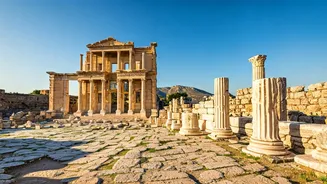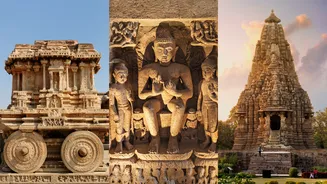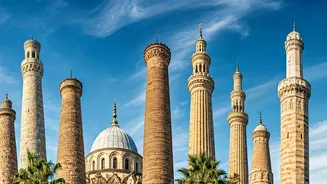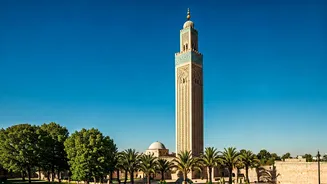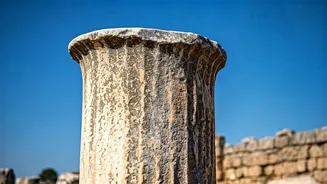Acropolis, Athens
The Acropolis in Athens, a UNESCO World Heritage site, dominates the Athenian skyline and is a quintessential symbol of ancient Greece. This citadel, dating
back to the 5th century BC, houses iconic structures like the Parthenon, a temple dedicated to the goddess Athena. The Parthenon's Doric architecture and intricate friezes are a testament to Greek artistic skill. Other notable structures include the Erechtheion, with its Caryatids (sculpted female figures serving as columns), and the Propylaea, the monumental gateway. Visiting the Acropolis provides a comprehensive understanding of classical Greek architecture, religious practices, and the ambition of Athenian society during its golden age. The site's elevated location provides stunning panoramic views of Athens, making it a truly immersive experience. These ruins provide a window into the artistic and political prowess of Ancient Greece, with each element meticulously crafted. The ongoing conservation efforts at the Acropolis ensure that future generations can witness its timeless beauty.
Delphi: The Oracle
Delphi, nestled on the slopes of Mount Parnassus, was considered the center of the world by the ancient Greeks and was home to the oracle of Apollo. Pilgrims from across the Greek world traveled to Delphi seeking prophecies and guidance. The archaeological site includes the Temple of Apollo, the Treasury of the Athenians, and a well-preserved theater. The Temple of Apollo was the primary location where the oracle delivered prophecies, influencing political decisions and personal lives. The remains of the Treasury of the Athenians showcase the wealth and architectural sophistication of the city-state of Athens. Delphi's theater provided a venue for dramatic performances and cultural events. Exploring Delphi provides a compelling view of ancient Greek religious beliefs, rituals, and the significance of prophecy in their lives. The landscape of Delphi, with its stunning views of the valley below, is as majestic as the ruins themselves, adding to the site's mystique and historical resonance.
Knossos, Crete
Knossos, located on the island of Crete, is the largest Bronze Age archaeological site on the island, and the center of the Minoan civilization. The palace of Knossos, with its intricate layout, vibrant frescoes, and advanced architectural features, provides crucial insight into Minoan society. The complex layout of the palace, including courtyards, workshops, and storage rooms, reflects the sophistication of Minoan urban planning. The vibrant frescoes, depicting scenes of daily life, religious rituals, and natural imagery, offer insights into Minoan art and culture. The site also includes the remains of a theater and various residential areas. Knossos provides a unique perspective on a pre-Greek civilization that thrived in the Aegean region. The palace's labyrinthine structure fueled the myth of the Minotaur, linking the site to Greek mythology. The exploration of Knossos enriches one's understanding of ancient civilizations, their architectural achievements, and their artistic legacies.
Olympia: Birthplace
Olympia, located in the Peloponnese region, is famed as the birthplace of the Olympic Games. The site includes the ruins of the Temple of Zeus, the stadium, and various other structures related to athletic competitions and religious rituals. The Temple of Zeus housed a massive statue of Zeus, one of the Seven Wonders of the Ancient World. The stadium, capable of holding thousands of spectators, hosted athletic events that were a central part of Greek culture. Olympia also featured training facilities, altars, and other structures that reflect the importance of sports and religious festivals in ancient Greek society. Visiting Olympia is an opportunity to learn about the origins of the Olympic Games, their religious significance, and the role of athleticism in ancient Greek life. The site's serene atmosphere, surrounded by olive groves, provides a perfect setting for appreciating the historical and cultural impact of the games.
Ephesus: Roman City
Ephesus, located in present-day Turkey (though historically part of the Greek world), was one of the largest and most significant cities in the Roman Empire. The site includes the Library of Celsus, the Temple of Artemis (one of the Seven Wonders of the Ancient World), and a well-preserved amphitheater. The Library of Celsus, with its magnificent facade and extensive collection of scrolls, was a center of learning. The Temple of Artemis, though largely in ruins, showcases the grandeur of ancient religious architecture. The amphitheater, capable of seating thousands of spectators, hosted gladiatorial contests and other public events. Ephesus flourished as a major trade and cultural center, attracting people from across the Roman Empire. Exploring Ephesus reveals the influence of Roman architecture, urban planning, and the intersection of Greek and Roman cultures. The city's ruins offer a glimpse into the diverse and cosmopolitan character of the ancient world.
Mycenae: Citadel
Mycenae, located in the Peloponnese region, was a powerful Bronze Age civilization that played a crucial role in Greek history. The site includes the Lion Gate, the Treasury of Atreus, and the remains of a citadel. The Lion Gate, with its iconic relief of two lions, is a symbol of Mycenaean power and architectural skill. The Treasury of Atreus, also known as the Tomb of Agamemnon, is a remarkable example of Mycenaean corbel arch construction. The citadel's fortifications, including cyclopean walls, showcase the advanced engineering capabilities of the Mycenaean civilization. Visiting Mycenae helps one understand the pre-classical period of Greek history and the evolution of Greek architecture and warfare. The strategic location of the citadel and its impressive fortifications point towards the Mycenaean civilization's military prowess and the importance of defense.
Ancient Corinth
Ancient Corinth, located near the Isthmus of Corinth, was an important city-state known for its strategic location and commercial activities. The site includes the Temple of Apollo, the Agora (marketplace), and other significant structures. The Temple of Apollo, with its Doric columns, reflects the architectural style of ancient Greece. The Agora served as a center for trade, social gatherings, and political activities. Corinth's location on a major land route and its control of key trade routes made it a wealthy and influential city-state. Exploring Ancient Corinth offers a view into the commercial and political life of the ancient Greeks, along with their engineering skills. The ruins demonstrate how geography and commerce shaped the development of ancient civilizations.
Delos: Sacred Island
Delos, a small island in the Cyclades, was considered a sacred site and a major religious sanctuary in ancient Greece. The island was believed to be the birthplace of Apollo and Artemis, and it attracted pilgrims from throughout the Greek world. The site includes the Terrace of the Lions, temples dedicated to various gods, and the remains of residential areas. The Terrace of the Lions, lined with marble statues of lions, is a well-known landmark. Delos' strategic location in the Aegean Sea contributed to its commercial importance. Visiting Delos gives insight into the religious practices and the role of sanctuaries in ancient Greek life, while also highlighting the island's role as a commercial hub. The archaeological remains reveal Delos as a place of worship, trade, and cultural exchange.
